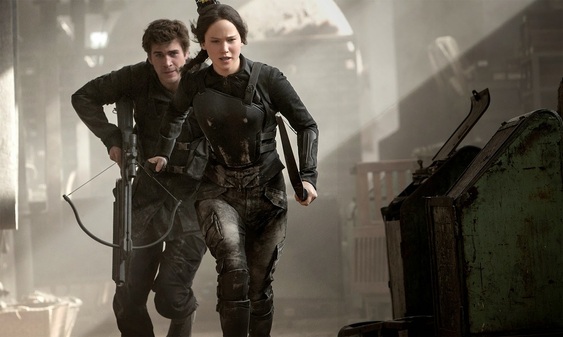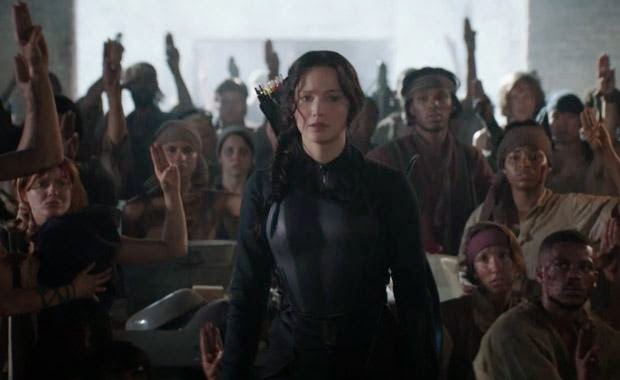
The film adaptations of Suzanne Collins’ The Hunger Games trilogy are no stranger to meta-criticism of visual media. The Hunger Games (Ross, 2012) made us think about violence depicted in media, using jarring depictions of children murdering other children. Catching Fire (Lawrence, 2013) offered a look into the painful life of stars abused for their stardom by producers and other powers that be, after Jennifer Lawrence and the Hunger Games franchise had emerged as a national and world-wide popular phenomenon. And now Mockingjay: Part 1 (Lawrence, 2014) continues the trend, exploring the ways that filmmakers try to recapture the emotions and energy of past successes, and the degree to which they are able to reclaim it it.
Katniss Everdeen (Jennifer Lawrence) knows what it’s like to be used to advance an agenda. Under the control of the Capitol, she was touted as a breakout star, “the girl on fire,” by Capitol talk show host Caesar Flickerman (Stanley Tucci). She toured the nation in an attempt to qualm unrest and distract the people of the districts from the injustice of their slavery and of the hunger games. When the Capitol tries to put her to death by sending her to the quarter-quell in the latter part of Catching Fire, she steps into another symbolic role—the Mockingjay. This isn’t defined as a symbolic role at all until the last moment, when she shoots her arrow at the sky, and instantly becomes a hero of the rebellion.
However, because she was on the other end of the cameras filming her, Katniss has no idea that she was this symbol of resistance until her rescue by the revolutionary forces of the underground district 13, after which President Alma Coin (Julianne Moore), the leader of the rebellion, tells her so. And the first order of business for the leaders of district 13 is to convince Katniss to be the face of their cause. There are many parallels between her use as the “Mockingjay” by the rebellion and the “Girl on Fire” by the Capitol. Although the film never openly addresses this, it is clear that Katniss is uncomfortable being ordered around, even for what seems to be a cause she cares about.
At this moment, if we step back from the movie itself, we can reflect on the presence of escalation in film trilogies and series, journalism and TV shows. Very often, when something works in a story (and it is decided that there will be a sequel, another season, or in the interest of increased ratings), instead of trying something new, writers try to recapture the original, seeking ways to get the audience to react in the same way, only better and bigger—if that means more explosions, more sex, more jokes, or even more of the same plot line. It is ironic then, that Mockingjay tackles this subject, because it is theatrically mellower than the first two installments. The point of this movie, as a “part 1,” is not to be bigger and better, but to develop and continue the plot and the characters genuinely. How well it does this is up for debate, and although the movie both started and ended on a “plateau” in terms of dramatic tension, I think it did its job.




 RSS Feed
RSS Feed
